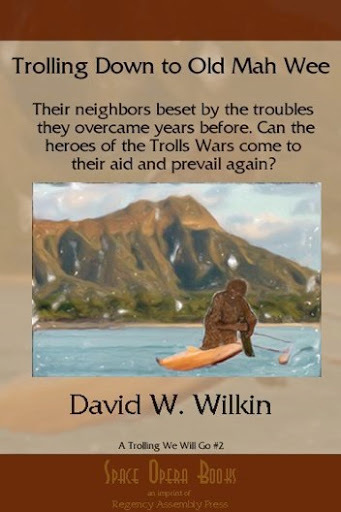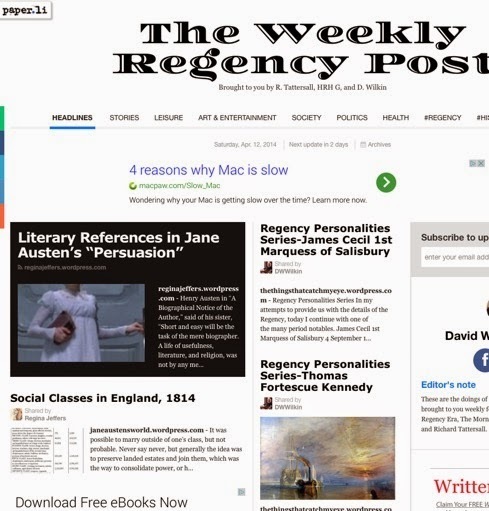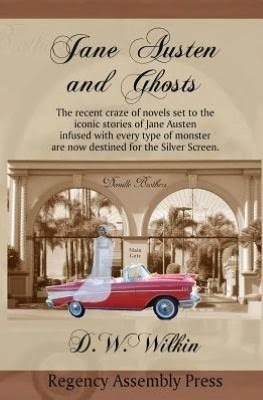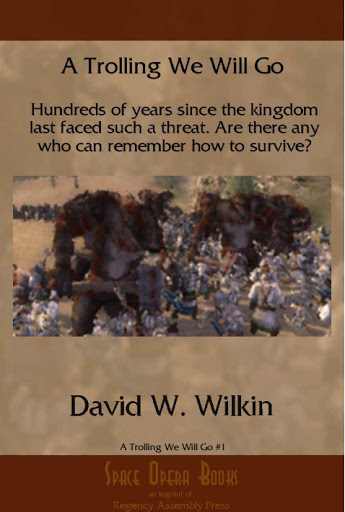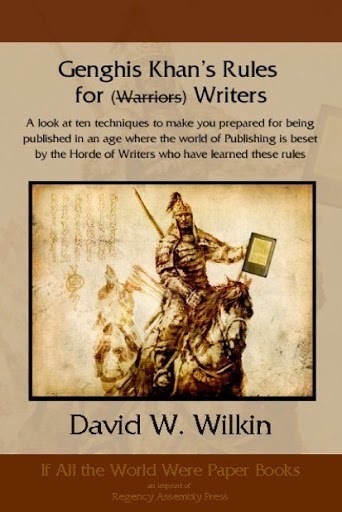D.W. Wilkin's Blog, page 171
November 10, 2014
Trolling Down to Old Mah Wee, another Fantasy
Trolling Down to Old Mah Wee
Not only do I write Regency and Romance, but I also have delved into Fantasy.
The Trolling series, (the first three are in print) is the story of a man, Humphrey. We meet him as he has left youth and become a man with a man’s responsibilities. We follow him in a series of stories that encompass the stages of life.
We see him when he starts his family, when he has older sons and the father son dynamic is tested. We see him when his children begin to marry and have children, and at the end of his life when those he has loved, and those who were his friends proceed him over the threshold into death.
All this while he serves a kingdom troubled by monsters. Troubles that he and his friends will learn to deal with and rectify. It is now available in a variety of formats.
For $2.99 you can get this 2nd book in the fantasy adventure series of Humphrey and Gwendolyn.
Barnes and Noble for your Nook
When the neighboring kingdom of Mah Wee begins to experience the same problems that beset Torahn some years before, they urgently request the aid of the experts in containing a new Troll infestation. But eradicating Trolls is not as easy as exterminating a few rats or mice.
Trolls are bigger than men, they are stronger than men, and then are meaner than men. Humphrey Cutter and his band of mismatched warriors must once again rise to the occasion, but can they without the aid of expertise of Gwendolyn and her particular skills?
Mah Wee, an ancient kingdom, with a monarch more steeped in the rights of being a king rather than the obligations and duties that a king should be. Here Humphrey and his crew finds that they have more than Trolls to overcome if they are to save Mah Wee from the same or nearly similar problems that they faced before in Torahn.
But, as Humphrey knows, nothing can truly be accomplished if the lovely Gwendolyn is not able to lend her aid as well.
Feedback
If you have any commentary, thoughts, ideas about the book (especially if you buy it, read it and like it ;-) then we would love to hear from you.


November 9, 2014
Regency Personalities Series-James Hook (Composer)
Regency Personalities Series
In my attempts to provide us with the details of the Regency, today I continue with one of the many period notables.
James Hook (Composer)
3 June 1746 – 1827
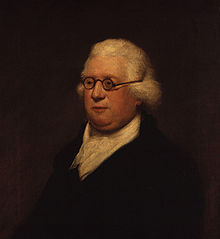
James Hook
James Hook was born in Norwich, the son of James Hook, a razor-grinder and cutler. He displayed a remarkable musical talent at an early age, playing the harpsichord by the age of four and performing concertos in public at age six. He began performing regularly by the time he was 10 years old, including benefit concerts. He held many jobs to earn money, including teaching, composing, transcribing music and tuning keyboard instruments.
Sometime between June 1763 and February 1764 Hook moved to London. There he became the organist at White Conduit House, Pentonville, one of the tea gardens that were popular in 18th-century London. He worked as an organist, teacher and composer, and gained a reputation for composing vocal music. He married the artist and writer Elizabeth Jane Madden on 29 May 1766, at St. Pancras Old Church. They had two sons, James (1772–1828) and Theodore Edward (1788–1841).
Hook was appointed organist and composer to Marylebone Gardens in 1768. In addition to his performances as an organist, and occasionally on the harpsichord, he was now invited to perform concertos between the main works in the theatres, and his short musical entertainments and comic operas were being produced for the pleasure gardens and in the London theatres.
He was appointed organist of St Johns Horselydown, Bermondsey, in 1772, and frequently played concerts on newly built organs, both in London and in nearby counties, often playing his own compositions, he was highly successful as a teacher of organ and harpsichord. Hook remained at Marylebone Gardens until the end of the 1773 season, and a year later was engaged in a similar position at Vauxhall Gardens, where he worked until 1820.
Throughout these years he composed operas and other musical works, most of which were produced at Drury Lane and Covent Garden Theatres. He frequently collaborated with family members. His wife Elizabeth wrote the libretto for the opera The Double Disguise (1784). His son James provided librettos for Jack of Newbury (1795) and Diamond Cut Diamond (1797), while Thomas Edward composed librettos for at least eight operas.
On 18 October 1805 Hook’s first wife, Elizabeth Jane Madden, died. A year later, on 4 November 1806, he married his second wife, Harriet Horncastle James.
In 1820 he unexpectedly left his position at Vauxhall, after almost a half century of service, and he died seven years later in Boulogne.
Stage works
Trick Upon Trick (pantomime), July 1772, Op. 3
Cupid’s Revenge (pastoral farce), 12 June 1772, Op. 8
The Lady of the Manor (comic opera), 23 November 1778, Op. 20
Too Civil by Half (farce), 5 November 1782, Op. 25
The Double Disguise (farce), 8 March 1784, Op. 32
The Fair Peruvian (comic opera), 18 March 1786, Op. 45
The Feast of Anacreon (serenata), 24 May 1788, Op. 53
Look ere you Leap (serenata), 2 June 1792, Op. 69
Jack of Newbury (comic opera with masque), 6 May 1795, Op. 80
Diamond Cut Diamond, or Venetian Revels (comic opera), 23 May 1797, Op. 89
The Wreath of Loyalty, or British Volunteer (serenata), 31 July 1799, Op. 94
Wilmore Castle (comic opera), 21 October 1800, Op. 96
The Soldier’s Return or What Can Beauty Do? (comic opera), 23 April 1805, Op. 108
The Invisible Girl (operatic farce), 28 April 1806, Op. 112
Catch him who Can (farce), 12 June 1806, Op. 113
Tekeli, or the Siege of Montgatz (melodrama), 24 November 1806, Op. 114
The Fortress (melodrama), 16 July 1807, Op. 117
Music Mad (comic sketch), 27 August 1807, Op. 119
The Siege of St Quintin, or Spanish Heroism (drama), 10 November 1808, Op. 122
Killing no Murder (farce), 21 August 1809, Op. 129
Safe and Sound (comic opera), 28 August 1809, Op. 130
Sharp and Flat (operatic farce), 4 August 1813, Op. 140
Large Vocal Works
Many oratorios and odes
Chamber Music
Six Sonatas For Violoncello and Piano, 1783
Six Solos for Flute and Harpsichord, ca.1774
Six Trios for Three Flutes, ca.1795, Op. 83
Keyboard Sonatas
Six Familiar Sonatas, 1798
Concerti
Works for the clarinet, organ, fortepiano, etc.
Songs
Over 2,000 Songs, most notably The Lass of Richmond Hill
Pedagogical works
Guida di musica, Being a Complete Book of Instructions for Beginners on the Harpsichord or Piano Forte … to which is added 24 Progressive Lessons (c1785), Op. 37
Guida di musica, Second Part, Consisting of Several Hundred Examples of Fingering … and *Six Exercises … to which is added, a Short … Method of learning Thoro’ bass … (?1794), Op. 75
The Preceptor for the Piano-Forte, Organ or harpsichord … Favorite Airs … a Collection of Progressive Lessons … [and] Two Celebrated Lessons (?1795)
New Guida di musica, Being a Compleat Book of Instructions for Beginners on the Harpsichord or Piano Forte … to which is added 24 Progressive Lessons (1796), Op. 81


The Weekly Regency Post
A play upon The Morning Post that was published in the Regency Era. A newspaper owned by R. Tattersall and His Royal Highness, Prince George.
This is a weekly wrap-up of posts from various sources who write regency posts brought to you on a Sunday.
Visit at The Weekly Regency Post


November 8, 2014
Regency Personalities Series-Alexander Horn
Regency Personalities Series
In my attempts to provide us with the details of the Regency, today I continue with one of the many period notables.
Alexander Horn
1762–1820
Alexander Horn was a Scottish Benedictine monk who became a British secret agent and diplomat. His work contributed to the birth of the conspiracy theory of the illuminati.
Horn was born in the village of Oyne, County of Aberdeen, in the Kingdom of Great Britain. In 1772, at the age of ten, he was accepted as an oblate by the Scots Monastery in Regensburg, Germany, an imperial abbey in the capital which was then the seat of the Imperial Diet of the Holy Roman Empire. About 1782, when he had come of age, he was admitted to the monastic community as a monk and given the religious name of Maurus and was ordained a Catholic priest around 1785. He was an esteemed librarian at the monastery by 1790, while at the same time working as the Regensburg agent for the British ambassador in Munich. He cultivated close ties with the Thurn und Taxis family and other influential people in the region. Despite being a monk, his social life led to him being described as a “wild young fellow”.
Horn wrote anonymously, condemning France’s activities in undermining the Holy Roman Empire. He supplied the material that formed the core of John Robison’s 1797 allegation of an international conspiracy of freemasons, illuminati, and Jacobins. In 1799 he travelled to England, meeting with members of William Pitt’s government including Earl Spencer. He subsequently used his bibliographical expertise to acquire rare books and manuscripts for Spencer’s library.
When in 1802 the Eternal Diet of Regensburg, under pressure from Napoleon Bonaparte, determined to secularize all property of the Catholic Church within the Empire, the Scots Monastery was uniquely successful in avoiding this fate. Horn and his abbot, Charles Arbuthnot, OSB, (the last abbot of the monastery) lobbied Jacques MacDonald and Jacques Lauriston, Scottish Catholic generals in the French army. He was by now the official British agent in Regensburg and further appealed to the British government. The Scots Monastery was exempt from German church authorities coming under the sole authority of Holy See and the two monks successfully obtained the support of the Cardinal Protector of Scotland in Rome. An express exemption was made in favour of the Scots Abbey, although it was not allowed to take any new novices.
In 1804 Horn became the official Chargé d’affaires following the expulsion of the British ambassador in Munich at the instance of Napoleon.


November 7, 2014
Regency Personalities Series-William Montagu 5th Duke of Manchester
Regency Personalities Series
In my attempts to provide us with the details of the Regency, today I continue with one of the many period notables.
William Montagu 5th Duke of Manchester
21 October 1771 – 18 March 1843
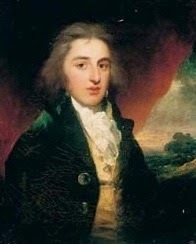
William Montagu
(Note picture is copyrighted by Oxford University Press)
William Montagu 5th Duke of Manchester was the eldest surviving son of George Montagu, 4th Duke of Manchester, and Elizabeth, daughter of Sir James Dashwood, 2nd Baronet. He was educated at Harrow and then served in the British Army, achieving the rank of colonel in 1794.
Manchester was Governor of Jamaica from 1808 to 1827, and prepared the colony for the emancipation of slaves. In 1815 he dealt with the aftermath of the destruction of Port Royal by fire and of the plantations by a hurricane. He showed great administrative ability during the panic which prevailed in the colony following an insurrection of slaves in Barbados, and by his personal influence pacified the Jamaica slaves. The colony gratefully voted him an addition to his personal establishment. In 1816 he risked his popularity with the planters by vigorously supporting a bill for the registry of slaves, in accordance with the recommendation of the imperial government.
In 1820 Manchester was thrown from his carriage and fractured his skull. The assembly voted 500 guineas to the surgeons who attended him. After recuperating in Europe, Manchester returned in 1822, and the last years of his administration were marked by the introduction of measures preparatory to the emancipation of the slaves, which the planters solidly resisted. The Jamaica government was called upon by the Colonial Office to abolish Sunday markets, to forbid the carrying of whips, and to exempt women from flogging. All these reforms were carried out with great difficulty. In 1824 there was a slave insurrection in the west of the island, and a plot was apparently discovered for the massacre of the white inhabitants in the north and east. The assembly rejected a bill allowing slaves to give evidence, but Manchester succeeded in securing a temporary measure to be in operation for five years. In this form, however, the law was vetoed by the home government, but before the imperial decision was known a conviction for murder was obtained by the evidence of slaves given under the temporary law. In the midst of the consequent confusion Manchester finally left Port Royal on 2 July 1827.
Soon after his return to England Manchester was appointed postmaster-general in the duke of Wellington’s ministry. He voted with his leader on Catholic emancipation, but against the Reform Bill in the House of Lords. He also voted for Lord Lyndhurst’s motion to postpone the disfranchisement clauses.
Manchester married Lady Susan, third daughter of Alexander Gordon, 4th Duke of Gordon, on 7 October 1793. They had eight children:
Lady Jane Montagu (1794–1815).
George Montagu, 6th Duke of Manchester (1799–1855).
Lord William Francis Montagu (1800–1842), married Emily, third daughter of James Du Pre.
Lady Georgiana Frederica Montagu (1803–1892), married Evan Baillie and had issue.
Lady Elizabeth Montagu, married Thomas Steele and had issue, including Thomas Montagu Steele
Lady Susan Montagu (c. 1801–1870), married George Hay, 8th Marquess of Tweeddale and had issue.
Lady Caroline Catherine Montagu (c. 1804–1892), married John Calcraft and had issue.
Lady Emily Montagu (1806–1827).
The Duchess of Manchester caused a social scandal when she eloped with one of her footmen. According to The Complete Peerage, “it is mentioned in the Memoirs of a Highland Lady, under date 1812, that ‘the Duchess had left home years before with one of her footmen.’ Lady Jerningham wrote, 6 September 1813: ‘the Duchess of Manchester is finally parted from her husband, her conduct becoming most notoriously bad.’
Having become a social outcast, she died at Eaton, Edinburgh, in August 1828, aged 54. Manchester survived her by fifteen years and died in Rome, Italy, in March 1843, aged 71. He was succeeded in the dukedom by his son, George.


Jane Austen Fans Rejoice, Jane is BACKKKK… Jane Austen and Ghosts
Special Sale Price!
Jane Austen and Ghosts.
Not only do I write Regency and Romance, but this can take a humorous turn. Some years back, I am sure readers of this blog will be aware that some writers began to take great liberty with Jane Austen and her works. Pride and Prejudice being liberally rewritten with the inclusion of zombies.
Then other books appeared with sea monsters, and werewolves and vampires. President Lincoln has even made it to the big screen where he is intent on sending foul creatures to hell. It occurred to me, even before I read any of this literature, that Jane would probably not appreciate what had been done to her classic piece.
That the tales and her life have become visual spectacles that we enjoy she might not like either, but is perhaps resigned to. That zombies, ghosts and vampires are now used to follow her own plot lines would I think, have her turning over in her grave. Jane Austen and Ghosts is my take on that.
It is now available in a variety of formats. For a limited time it has been reduced to $2.99 for your eReaders and $8.99 for paperback you can get this Jane Austen adventure.
Barnes and Noble for your Nook
and in Paperback
In the world of moviemaking, nothing is as golden as rebooting a classic tale that has made fortunes every time before when it has been adapted for the silver screen.
Certainly any work by Jane Austen made into a movie will not only be bankable, but also considered a work of art. That is of course until the current wave of adaptations that unite her classic stories with all the elements of the afterlife is attempted to be created.
That these have found success in the marketplace amongst booklovers may not be quite understood by those who make movies. But that they are a success is understood and a reason to make them into movies.
All that being said, perhaps it would also be fair to say that the very proper Jane, were she present to have anything to say about it, would not be pleased. Of course she has been away from this Earth for nearly 200 hundred years.
But does that mean were she upset enough, she wouldn’t come back?
Feedback
If you have any commentary, thoughts, ideas about the book (especially if you buy it, read it and like it ;-) then we would love to hear from you.


November 6, 2014
Regency Personalities Series-Anna Maria Crouch
Regency Personalities Series
In my attempts to provide us with the details of the Regency, today I continue with one of the many period notables.
Anna Maria Crouch
April 20, 1763 – October 2, 1805
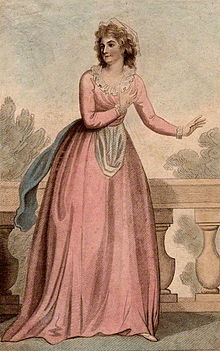
Anna Maria Crouch
Born Anna Maria Phillips, she first went on stage as a child, acting and singing. Articled to Thomas Linley, she made her debut at Drury Lane theatre in 1780 as Mandane in Thomas Arne’s Artaxerxes, and became a principal in the regular company of the theatre under the management of Sheridan and Linley. In 1781 she made a great success as the heroine in Charles Dibdin’s Lionel and Clarissa. She was a notable Ophelia, Olivia and Celia. Her Polly Peachum in The Beggar’s Opera was well-known. In 1787 her stage partnership began with the Irish actor and singer, Michael Kelly, on his arrival in London with Stephen and Nancy Storace from the Viennese court.
In 1784 she had married a naval lieutenant named Crouch. In 1790 she was at Brighton to perform at the opening of the Duke Street Theatre. By 1791, her marriage was suffering, and she was deeply involved in an affair with Kelly. However, this did not prevent her from entering into an affair with the Prince of Wales, occurring while he was living with Maria Anne Fitzherbert. The affair was brief, but she benefited financially, with the general belief being that she received somewhere in the amount of 10,000 pounds from the Prince when the affair ended. Following her marital separation from Crouch in 1791, her domestic partnership with Michael Kelly became generally known.
She died suddenly, of unknown causes, on October 2, 1805, while in Brighton. There are reports that indicate that her death was possibly as a result of a carriage accident. She is buried in St. Nicholas’s churchyard, Brighton.


Space Opera Books Presents A Trolling We Will Go (Book #1)
A Trolling We Will Go
Not only do I write Regency and Romance, but I also have delved into Fantasy.
The Trolling series, (the first three are in print) is the story of a man, Humphrey. We meet him as he has left youth and become a man with a man’s responsibilities. We follow him in a series of stories that encompass the stages of life.
We see him when he starts his family, when he has older sons and the father son dynamic is tested. We see him when his children begin to marry and have children, and at the end of his life when those he has loved, and those who were his friends proceed him over the threshold into death.
All this while he serves a kingdom troubled by monsters. Troubles that he and his friends will learn to deal with and rectify.
It is now available in a variety of formats. For $.99 you can get this fantasy adventure.
Barnes and Noble for your Nook
The Valley Kingdom of Torahn had been at peace for fifty years since the Council of Twenty-One saw fit to dispense with their royal family.
The only Kingdom without a King on the west side of the continent. But late last year, something caused the Goblins in the Old Forest, Karasbahn to stir and act courageous.
Something that men can not remember seeing Goblins ever doing. What has gotten the Goblins in such a state?
Whatever it is, it can not be good news for Torahn. Or for Humphrey, a woodcutter for a small town, far from Karasbahn.
But part of the Kingdom’s militia, with no family or other exemptions. He is perfect to be sent to the Old Forest and find out what scares the Goblins that they have become fearless.
Feedback
If you have any commentary, thoughts, ideas about the book (especially if you buy it, read it and like it ;-) then we would love to hear from you.


November 5, 2014
Regency Personalities Series-Sir Henry Wyndham
Regency Personalities Series
In my attempts to provide us with the details of the Regency, today I continue with one of the many period notables.
General Sir Henry Wyndham
12 May 1790 – 3 August 1860
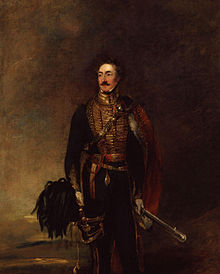
Henry Wyndham
Sir Henry Wyndham was a British Army General and Conservative Party politician. He was Member of Parliament (MP) for Cockermouth from 1852 to 1857 and for West Cumberland from 1857 to until his death in 1860.
Wyndham was the second son of George Wyndham, 3rd Earl of Egremont (1751–1837) and Elizabeth Ilive (died 1822), of Petworth House, near Chichester, West Sussex, and a descendant of John Wyndham who played an important role in the establishment of defence organisation in the West Country against the threat of Spanish invasion.
As a young officer, then-Captain (Guards officers held ‘double’ rank, so a Captain was also a Lieutenant-Colonel) Henry Wyndham fought at the Battle of Waterloo in 1815, where he was severely injured. He had taken part in the famous closing of the gates at Hougoumont and was said to have been so disturbed by the incident that he would never again close a door, preferring to sit in a room in a howling draught. During the battle, his life had been saved by Corporal James Graham, the soldier responsible for slotting the bar home after the North Gate was shut.


Rules for better writing from Genghis Khan
The Rules for Writers
Those who follow me for a long time know that I also write in other fields aside from Regency Romance and the historical novels I do.
A little while ago, before the end of 2011 and the 2011 NaNoWriMo, (where I wrote the first draft of another Regency) I started work on a project about writing.
The premise was what one should think about when starting and working on a project. I came up with 10 rules to follow in a quest to become a writer and tackle that novel.
Here are The 10 Rules:
1) Read like a writer
2) Have a good story
3) Your work will be Thematic
4) Plot: The seven deadly ones
5) Characters will carry your tale, near and far
6) Words are your warriors
7) Stories are structured
8) All tales building to a Crescendo
9) Genghis edits history, shouldn’t you as well
10) Act like a writer
So it is now released. For $4.99 you can get this treatise on honing your skills.
Barnes and Noble for your Nook
Genghis Khan came from the Steppes of Mongolia, a family torn apart by neighboring tribes, to unite those tribes, or defeat them, and then conquer the greater part of the known world. His heirs would continue his conquest right to the edge of western society. The world feared the Mongols, and Genghis. Now, you can benefit, as a writer from the lessons he has to impart on how, with the changing world of publishing, you can perfect your work and write not only good material for this new age of book publishing. But can write great work for this new age. 10 simple lessons, and you will be on your way to conquering the bookshelves of the 21st century. This short book will have you learning all you really need to know to elevate your writing to the next level. These simple lessons will start you on the road to better writing as a member of the Horde in no time.
Feedback
If you have any commentary, thoughts, ideas about the book (especially if you buy it, read it and like it ;-) then we would love to hear from you.



